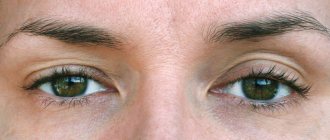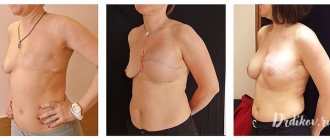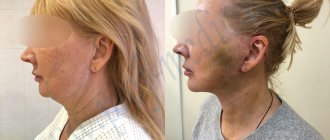Purulent mastopathy and breast cancer are diseases that cannot be ignored. They require intense attention, examination and treatment. Breast cancer ranks first among oncological diseases in women, and second among other diseases. The consequences cannot always be predicted.
Prevention and timely treatment are important. In some cases, surgery—radical mastectomy—is inevitable.
What is radical mastectomy
Radical, i.e., removing entirely, completely, from the roots. The concept of mastectomy is of Greek origin - mastòs “breast” and ek tome “remove”. The term is over 100 years old.
Several types of mastectomy are practiced. Each of them is effective, they differ in the degree of trauma. Radical mastectomy is a complex operation, but sometimes it is the only one that can solve the existing problem.
There are three main types of mastectomy:
- according to Madden,
- by Patey,
- according to Halstead.
Radical mastectomy according to Madden is considered the most gentle.
Carefully! The video shows a radical mastectomy (click to open)
[collapse]
general information
The operation involves removal of the affected gland, and, if indicated, excision of axillary lymph nodes and pectoral muscles in combination with fatty tissue. The type of surgical intervention depends on the size and stage of the tumor, the presence or absence of metastases, and the type of tumor.
Important details:
- timely removal of ductal carcinoma, sarcoma, and other types of tumors reduces the risk of an extensive pathological process and the formation of distant foci with atypical cells,
- When a mutated BRCA1 gene is detected, prophylactic mastectomy, removal of mammary glands in case of a precancerous condition or a family history of cancer pathologies, is effective. After a preventive mastectomy, the risk of developing a malignant process is reduced from 90 to 34%. It is important to take into account the indications and limitations, learn about possible complications and consequences, advantages and disadvantages of the operation,
- Contacting a mammologist at an early stage of cancer pathology allows you to get by with organ-conserving surgery. In advanced cases of cancer, the active process of metastasis requires excision of the affected mammary gland,
- You should not refuse a complete radical mastectomy if the mammologist insists on this type of operation: the sooner the tumor stops its negative impact on the body, the more favorable the prognosis of therapy.
Breast removal requires highly qualified breast surgeons. A complex operation is performed under general anesthesia and lasts 3 hours or more. The duration of surgical intervention increases during reconstructive plastic therapy.
Learn about the symptoms of progesterone deficiency, as well as ways to replenish the hormone deficiency.
Instructions for using the drug Gordox for the treatment of pancreatitis of the pancreas are described on this page.
Several modern technologies are used to perform a mastectomy:
- Madden mastectomy. The surgeon removes only the affected gland; the lymph nodes and chest muscles are not affected. Indications: development of ductal carcinoma, preventive mastectomy for hereditary predisposition to cancer,
- Patey's method. During the operation, the doctor excises not only the gland with the tumor, but also the pectoralis minor muscle and lymph nodes in the armpits. Indications: confirmed breast cancer, presence of metastases,
- Halstead method. During the operation, the surgeon cuts out the affected gland, adjacent lymph nodes, pectoral muscles and fat in this area. The important thoracic nerve is not affected. Indications: extensive tumor process, there are metastases, chest muscles are affected.
To reduce the risk of depression and eliminate a severe cosmetic defect, one-stage breast plastic surgery is performed after excision of the problematic element.
Kinds
According to Madden
The method involves preserving both pectoral muscles, which makes it as gentle as possible. The mammary gland is removed en bloc with lymph nodes and subcutaneous fat layer.
After removing the mammary gland, all nerve endings and vascular links are traced, which helps to avoid blood loss. This type of operation has significant advantages: preservation of radicality, relatively low morbidity, low percentage of complications.
According to Halstead
Halstead-Meyer mastectomy is a classic operation. The mammary gland, skin, subcutaneous tissue, pectoral muscles, subcutaneous fatty tissue (subclavian, axillary and subscapular region), and lymph nodes are removed as a single complex.
The method often causes complications, the main one of which is limited mobility of the shoulder joint. It is used extremely rarely when other methods do not help to cope with the problem, for example, extensive metastases affecting the pectoral muscle, lymph nodes, etc.
By Patey
Patey's mastectomy is a modification of the previous type and has the full name - modified radical mastectomy. Its founder, Dr. Patey, proposed wide excision of the skin and preservation of the pectoralis major muscle. During the operation, only a small muscle is removed, which makes the method more gentle and avoids serious complications.
According to Pirogov
The mammary gland and tissue of the axillary region are removed.
Simple mastectomy
The mammary gland and fascia of the pectoralis major muscle are removed.
Technique using tram flap
A technique for breast restoration, which is performed simultaneously with a mastectomy or six months after surgery. In this case, the patient's own tissue is moved, which is called a TRAM flap, which is tissue with preserved blood flow. This may be an iliofemoral flap or a greater omentum flap. Sometimes a pedicled rectus abdominis muscle flap (along with skin) is used.
Subcutaneous surgery technique
A technique that allows you to maintain the radicality of surgical intervention and achieve the best possible aesthetic results. This is a method of extended subcutaneous mastectomy, when the mammary gland with muscular fascia (sheath) and lymph nodes are removed, while preserving the muscles and fatty tissue. P
When using this technique, breast reconstruction surgery can be performed at the same time. This can be an operation using your own tissue or using an implant, for which a “pocket” is pre-formed.
Carefully! The photo shows a breast after a radical mastectomy (click to open)
[collapse]
Life doesn't end after a mastectomy. This is evidenced by the very happy fates of women who underwent such an operation. Moreover, some of them underwent such an operation, not even when a cancerous tumor was detected, but as a preventive measure for a genetically hereditary predisposition. Below are twenty famous women who have undergone mastectomy surgery. Among them are actresses, writers, politicians, popular TV presenters and others. Below is a photo of singer Kylie Minogue and actress Angelina Jolie:
This list is dominated by Western famous women, but only because they were not shy about divulging such details about themselves. Information about them simply lies on the surface; it is easier to find in the press and the Internet.
In fact, there are no less famous Russian women who have had such an operation and live happily...
1. Popular Russian writer Daria Dontsova underwent more than a dozen surgical operations after she was diagnosed with stage 4 cancer. mastectomy. She openly talks about the fact that she had to undergo severe radiation therapy and chemotherapy courses, and a number of difficult operations. How she finally defeated the disease, what methods of combating the disease were used in her case. 2. America's First Lady - Nancy Reagan, wife of President and actor Ronald Reagan, deliberately chose and performed a mastectomy many years ago. Now she has recovered well and considers this justified and necessary. 3. America's First Lady, Betty, President Ford's wife, underwent a radical mastectomy. Her example allowed many women to be confident that the disease could be eliminated without consequences. 4. Russian journalist Masha Gessen decided to undergo a preventive mastectomy operation for genetic reasons. She wrote a book about her difficult decision and the trials she faced along the way. 5. Popular TV presenter and authoritative journalist Giuliana Rancic treated the disease with therapeutic methods for a long time to no avail. Then she agreed to undergo surgery and now only regrets that she did not do it right away, saving herself from difficult procedures. 6. Film actress Christina Applegate, known from the TV series “Friends” and other films, decided to undergo surgery due to the risk of a hereditary predisposition. Explaining that her mother’s similar illness haunted her, she stated the following (the translation may not be entirely accurate): “I was exhausted from being examined every 4 months, experiencing constant fear, I was forced to get rid of all this at once.” 7. The well-known Angelina Jolie, the most popular Hollywood actress, and currently the main media popularizer of the idea of preventive mastectomy. She made her conscious choice after discovering a mutated gene in her, performed the operation and told the whole world about it 8. Pop star and singer Anastacia had a mastectomy at the age of 45. In 2003, after discovering a tumor, she carried out a series of therapeutic measures and then agreed to surgery. Now Anastacia has undergone breast surgery using silicone implants. She finds her current condition excellent and strongly advises women not to fear mastectomies. 9. The creator of the world-famous Barbie doll, American Ruth Handler, underwent surgery with radical breast resection after discovering a breast tumor. Her personal experience encouraged her to design and produce her own line of exoforms for post-mastectomy women. 10. Australian singer and pop star Kylie Minogue, after undergoing a mastectomy, did a lot to popularize such operations. Being a pop idol for many people in the world, she managed by personal example to convince many women to agree to such an operation and thereby save their lives. 11. British supermodel Claire Farwell, who graced the covers of popular tabloids at the end of the last century, upon learning of the terrible diagnosis, fell into depression at the thought that her body would be mutilated. But in order to prolong her life, she still went for a mastectomy. Now she tells fans about her past experiences in order to psychologically help women around the world. In addition, Claire Farwell continues to act as a model and even with naked breasts devoid of nipples. 12. The famous star of the series “ER” and popular Hollywood actress Maura Tierney, after a double mastectomy, continues to act in films and remains in demand and popular. 13. Mother of three children Sharon Osbourne, wife of musician and rock star Ozzy Osbourne and part-time TV presenter. After the mastectomy operation, she continues to successfully work on television and produce her husband’s performances, managing to participate in raising children. 14. Helen Rose 24-year-old Miss America, who lost her mother at the age of 16 due to breast cancer, had a mastectomy for preventive purposes and does not regret it at all. Her popularity, she claims, has even increased. 15. Hollywood actress Kathy Bates, who was once nominated and received the prestigious Golden Globe and Oscar awards for her role in the film Misery, based on the Stephen King script, continued to successfully act in films after a mastectomy. She starred in J. Cameron's famous "Titanic" after the operation. 16. Wanda Sykes, a popular American actress and comedian, had both breasts removed after she was diagnosed with breast cancer. The tumor was discovered during cosmetic breast surgery. Now she often jokes at her performances (the translation may not be entirely accurate): “You can find positive sides in everything. I will never have breast cancer again.” 17. Pop singer from the English group “Liberty X” Michelle Heaton, having discovered breast tumors, went for resection of both breasts. After rehabilitation, she received endo implants and continues her career as a vocalist. After the announcement of the operation, she only gained new fans. 18. For the rock singer from the United States Sheryl Crow, the operation to remove the mammary glands became an incentive for new creativity. She released her most popular CDs after the operation. 19. Sex and the City actress Cynthia Nixon had to undergo a mastectomy for medical reasons. After a short break due to a period of rehabilitation, she continued acting. 20. Hollywood actress Olivia Newton-John, who starred alongside J. Travolta in the super-popular musical “Grease.” At the age of 44, she underwent a partial mastectomy and reconstructive breast surgery. Now she says that since 1992, freed from cancer, becoming more compassionate and tolerant, she looks calmly into the future.
About Rago shapewear here.
Read what type of mastectomy surgery is the most gentle
Contraindications
General contraindications:
- Severe cardiovascular failure,
- Kidney and liver failure,
- Decompensation of diabetes mellitus,
- Cerebrovascular accident.
Contraindications for tumor localization:
- Swelling of the mammary gland extends to the chest wall,
- Multiple metastases in the lymph nodes with edema of the upper limb,
- Invasion by a tumor of the chest.
Carefully! The video shows a radical mastectomy (click to open)
[collapse]
Bottom line
Mastectomy should not be a treatment that ends normal life. If there was no other choice but to remove the mammary gland, then this was the right decision. The result of mastectomy is the preservation of life and its duration. Now the woman’s only task is to maintain her health and mental state.
Removal of the mammary gland does not mean that a woman should give up on herself. You can be attractive without breasts if you use special underwear, which helps not only to create the illusion of breasts, but also to support prostheses.
The prognosis for using special underwear is favorable. Over time, all the seams are tightened, and the woman gets used to her new forms. This is an ideal solution for those who want to live despite having undergone a mastectomy.
Carrying out the operation
Preparation
Preparation for surgery consists of several stages:
- Medical examination , which is a fundamental point. The doctor examines the medical history and prescribes an examination,
- An examination that includes a number of tests and tests: mammography (photography of breast tissue), breast biopsy, general blood and urine analysis, biochemistry, blood clotting test (coagulogram).
- The doctor prescribes a gentle (light) diet , warns about limiting the intake (or completely stopping) of medications that thin the blood (aspirin, etc.). They are excluded a week before surgery. On the day of surgery, it is unacceptable to drink or eat.
Radical mastectomy according to Patey
Progress of the operation
The operation is performed under general anesthesia. Its duration ranges from 1 to 3 hours.
Algorithm:
- Markers are used to mark the upcoming cuts.
- The skin is cut in the necessary places,
- Subcutaneous tissue and mammary gland are separated from the skin,
- Removal occurs as a single block, including lymph nodes,
- Depending on the method, the pectoral muscle, fatty tissue, etc. are sequentially removed.
- Nerve endings and vascular links are traced,
- A drainage is installed through a special hole, which is removed on the 5th - 6th day.
- Stitches are applied and removed on days 10-12.
Installing drainage is an important point. The doctor monitors the outflow of fluid.
Preparation
Before prescribing a mastectomy, the surgeon collects the necessary tests:
- chest x-ray;
- CTG;
- mammography;
- Ultrasound of the chest, abdominal cavity and pelvic organs;
- tumor biopsy;
- histological and immunohistochemical examination of the tumor;
- clinical and biochemical blood test.
The doctor also examines the breast and reviews the patient’s medical history. This allows us to establish an accurate picture of the cause of the tumor. 7 days before surgery, you must stop taking medications that reduce blood clotting, stop drinking alcohol and smoking. You should not eat for about 8 hours before surgery. You should not drink 2 hours before the procedure.
Rehabilitation
After a mastectomy, rehabilitation measures are extremely important. These include gymnastics, physical therapy, and taking medications.
Gymnastics
Gymnastics, some examples of exercises:
- Squeezing a rubber ball
- Hair combing,
- Putting your hands behind your back, as if you are trying to fasten a button at the back,
- Circular movements of the arms, rocking, etc.
Physiotherapy
If there are no complications, then physical therapy can be prescribed a week after the operation. What can be done about this:
- Pool,
- Various simulators aimed at developing the shoulder joint,
- Massotherapy,
- Hydromassage,
- Red spectrum irradiation (used to restore lymphatic drainage),
- Magnetotherapy,
- Bandage,
- Therapeutic wrap.
Rehabilitation rules
- Using an elastic bandage
- Refusal to visit the bathhouse and solarium,
- You can't lift weights for a year,
- Stay in an inclined position for a long time,
- Try to avoid injuries, do not use traumatic objects (bracelets, etc.),
- Increase the amount of fluid you drink,
- When flying by air, you must use a compression sleeve,
- An examination is required every six months,
- Wearing special underwear,
- If you feel worse, consult a doctor immediately.
Lipofilling of the mammary glands after RM
Fat grafting is a means of breast reconstruction after mastectomy, which uses the patient's tissue rather than implants. One session for the recovery procedure will not be enough; several will be required.
Lipofilling of the mammary glands is also a serious matter that requires thorough preparation.
- The surgeon determines the areas from which the necessary material can be taken,
- Prescribes an examination similar to that required for any plastic surgery,
- The operation is performed under general anesthesia,
- Before collecting adipose tissue, Klein's solution is injected into it,
- Selected fat cells are placed in a centrifuge, where they are separated into 3 parts,
- The middle part is used for direct reconstruction,
- The prepared fatty tissue is injected using a syringe in small portions into the targeted areas.
The operation is performed under general anesthesia and lasts from 2 to 5 hours. After lipofilling, swelling and hematomas form, which persist for 3-4 weeks. Repeated surgery is possible no earlier than after 4 months. For a lasting result, 2 to 5 procedures are required.
Lipofilling involves the use of a special system (BRAVA), which protects the transplanted cells from external influences. This system is put on and worn for 7 to 14 days.
Consequences and complications
The number of complications after mastectomy continues to remain high today (from 20 to 87%), despite equipment and new technologies. Complications can be early or late.
Early
- Leakage of lymph, which may necessitate further surgery,
- Necrosis of tissue edges,
- Infection, suppuration.
Late
Late complications that are observed more often when using the Halstead method:
- Lymphostasis (impaired lymph outflow),
- Violation of the venous outflow of blood as a result of narrowing (blockage) of the lumen of the subclavian or axillary vein,
- Formation of rough scars involving the axillary nerves,
- Pain in the shoulder area
- Loss of mobility of the shoulder joint, which leads to disability.
Possible complications
The use of modern methods of resection of affected mammary glands in combination with comprehensive rehabilitation reduces the likelihood of an inflammatory process and the spread of metastases. Strict adherence to the recommendations given by the mammologist reduces the strength of negative feelings after a mastectomy.
After surgery, some patients experience complications:
- the hand swells when the outflow of lymphatic fluid is disrupted,
- phantom pain in the surgical area,
- bleeding and poor wound healing,
- skin necrosis, contractures,
- decreased mobility of the shoulder joint,
- erysipelas of tissue with further degeneration into more severe forms: abscess, sepsis,
- depressive states, especially in the absence of desire or opportunity for breast surgery,
- curvature of the spine, causing pain in the cervical area and poor posture.
An important factor that reduces the risk of complications is cooperation with a qualified mammologist-oncologist and surgeon. Mastectomy is a difficult operation. Inaccuracies during the removal of the gland, the choice of an inappropriate method of surgical treatment without taking into account the individual characteristics of the patient can lead to dangerous complications. You need to find a high-level clinic and an experienced doctor. Most medical institutions that use the latest equipment and an effective set of measures during the rehabilitation period offer women reconstructive plastic surgery to eliminate cosmetic defects.
Price and clinics
Mastectomy is a major operation that is performed exclusively in large or specialized centers. There are such centers in Moscow (for example, the CENTER OF MAMMOLOGY), St. Petersburg, Obninsk, Yekaterinburg, etc. The medical and Medical Diagnostics Center in Germany are often mentioned in connection with this operation.
Prices vary greatly, which is not surprising. Each operation has its own characteristics and different methods are used. Pricing also plays a role. The estimated minimum price threshold is 35 thousand rubles. It is possible to perform a simple mastectomy at a lower cost, but this is unlikely. Average prices for surgery range from 60 to 120 thousand rubles.










